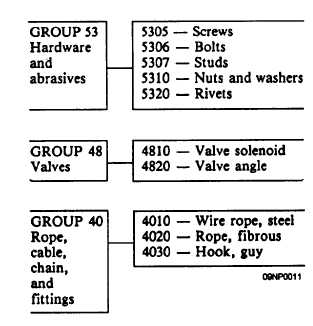| |
CHAPTER 4
MATERIAL IDENTIFICATION
This chapter discusses what is meant by material
identification. Why it is necessary. The way material
is identified, and the tools that are available for you to
use in identifying material. The problem of material
identification is not peculiar to the Navy nor to the
military. You probably have had occasion to purchase
a part for your car or for an appliance or to use a mail
order catalog. These items were all identified by a
catalog or part number. This is the material
identification system used by that manufacturer or
supplier. They use it for the same reason the Navy does.
It is a brief, accurate means of identifying one specific
item of material. Each company develops a system to
meet its own needs.
There are over four million supply items in the
Department of Defense (DOD) Supply System. The
Navy Supply System alone stocks over one million
items When requisitioning a specific item from a
supply activity, you must use the common language that
has been developed to accurately identify the item. This
tool is known as the Federal Supply Catalog System.
FEDERAL CATALOG SYSTEM
The Defense Logistics Agency (DLA), administers
the Federal Catalog System. This includes naming,
describing, classifying, and numbering of all the items
carried under centralized inventory control of the
Federal Government. The publication of related
identification data is also part of this task. The Federal
Catalog System also is used by North Atlantic Treaty
Organization (NATO) countries.
FEDERAL SUPPLY CLASSIFICATION
SYSTEM
The Federal Supply Classification (FSC) system is
designed to classify all items of supply used by the
Federal Government. Each item of supply is classified
in one, and only one, four-digit Federal supply class.
The first two digits denote the group or major division
of commodities the last two digits denote the class or
subdivision of commodities within a group. As
presently established, the FSC consists of 76 groups
(some currently unassigned). These stock groups cover
rather broad categories of material. Therefore, they are
subdivided into classes. There are approximatey 600
classes assigned to the 76 groups.
The number of classes within each group vary.
Each class covers a particular area of commodities, in
accordance with their physical or performance
characteristics, or based on the fact that the items in the
class are usually requisitioned or issued together. You
will learn the frequently used classes within the groups
by using them. Examples of how the classes are used
to divide types of material as shown in figure 4-1.
Together, the stock group and class are known as
the FSC.
The Defense Logistics Agency Cataloging
Handbooks, H2-1, H2-2, and H2-3 contain a complete
listing of assigned federal supply classification classes.
You will notice that the Federal supply groups starts
with group 10. The Navy uses the groups 01 through
09 for forms and publications which are not included in
the Federal Catalog System.
NATIONAL STOCK NUMBER
The national stock number (NSN) for an item of
supply consists of a four digit FSC group and class, and
Figure 4-1.-Classes of material within stock groups.
4-1
|

